![]()
![]()
![]()
Use LEFT and RIGHT arrow keys to navigate between flashcards;
Use UP and DOWN arrow keys to flip the card;
H to show hint;
A reads text to speech;
35 Cards in this Set
- Front
- Back
|
________ is an negative mood state characterized by bodily symptoms of physical tension and by apprehension about the future.
|
Anxiety
(Ch 5 p.121) |
|
|
T or F:
Anxiety is difficult to study in humans. |
True
Because it can take many subjective forms, such as a sense of unease, a set of anxious/worried/fidgety behaviors, or a physiological response in the brain reflected by elevated heart rate or muscle tension. (Ch 5 p.121) |
|
|
T or F:
Anxiety is closely related to depression. |
True
(Ch 5 p. 121) |
|
|
T or F:
Anxiety is good for us in moderate amounts. |
True
We perform better when we are a little anxious. Physical and intellectual performances are driven and enhanced by anxiety. (Ch 5 p.121) |
|
|
__________ is a future-oriented mood state.
|
Anxiety
(Ch 5 p. 121) |
|
|
T or F:
Too much or severe anxiety can be harmful. |
True
Severe anxiety usually doesn't go away -- that is, even if we "know" there is nothing to be afraid of, we remain anxious. (Ch 5 p.121) |
|
|
________ is an immediate alarm reaction to danger.
|
Fear
(Ch 5 p.122) |
|
|
Fear protects us by activating a massive response from the autonomic nervous system (increased heart rate/blood pressure), which along with our terror, motivates us to escape (flee) or possibly attack (fight). This is known as the ________ _________ response.
|
Fight or flight response
(Ch 5 p.122) |
|
|
T or F:
Fear and Anxiety reactions differ psychologically and physiologically. |
True
(Ch 5 p.122) |
|
|
_________ is a future-oriented mood state, characterized by apprehension because we cannot predict or control upcoming events.
|
Anxiety
(Ch 5 p.122) |
|
|
_______ is an immediate emotional reaction to current danger characterized by strong escapist action tendencies and a surge in the sympathetic branch of the autonomic nervous system.
|
Fear
(Ch 5 p.122) |
|
|
______ is when you experience the alarm response of fear when there is nothing to be afraid of -- that is, a false alarm.
|
Panic
(Ch 5 p.122) |
|
|
A ________ ________ is defined as an abrupt experience of intense fear or acute discomfort, accompanied by physical symptoms that usually include heart palpitations, chest pain, shortness of breath and dizziness.
|
Panic Attack
(Ch 5 p.122) |
|
|
Name the three types of panic attacks.
|
1. situationally bound - panic attacks that occur in a specific situation
2. unexpected - you have no clue when or where a panic attack might occur 3. situationally predisposed - you are more likely in a specific situation have a panic attack, but not always (Ch 5 p.122) |
|
|
__________ and _________ types of panic attacks are important in panic disorder.
|
Unexpected and situationally predisposed
(Ch 5 p.122) |
|
|
_________ _________ panic attacks are more common in specific phobias or social phobia.
|
situationally bound
(because these are specific situations) (Ch 5 p.122) |
|
|
T or F:
Increasing evidence shows that we inherit a tendency to be tense or uptight. |
True
(Ch 5 p.123) |
|
|
T or F:
A single gene causes anxiety. |
False
NO single gene seems to cause anxiety. Instead, contributions from collections of genes in several areas on chromosomes make us vulnerable to anxiety. (Ch 5 p.123) |
|
|
T or F:
The tendency to panic also seems to run in families and may have a genetic component. |
True
(Ch 5 p.123) |
|
|
The area of the brain most associated with anxiety is the ________ ________, which acts as the mediator between the brain stem and the cortex.
|
limbic system
(Ch 5 p.124) |
|
|
_________ _________ system is activated by signals from the brain stem of unexpected events, such as major changes in body functioning that might signal danger.
|
behavioral inhibition system (BIS)
When BIS is activated, our tendency is to freeze, experience anxiety, and apprehensively evaluate the situation to confirm that danger is present. (Ch 5 p.124) |
|
|
T or F:
One study suggests that cigarette smoking as a teenager is associated with greatly increased risk for developing anxiety and its disorders as adults, particularly panic disorder and generalized anxiety disorder. |
True
(Ch 5 p. 124) |
|
|
T or F:
A general "sense of uncontrollability" may develop early as a function of upbringing and other environmental factors. |
True
(Ch 5 p.125) |
|
|
Stressful lie events trigger our ________ and ________ vulnerabilities to anxiety.
|
biological and psychological
(Ch 5 p.125) |
|
|
T or F:
The particular way we react to stress seems to run in families. |
True
(Ch 5 p. 125) |
|
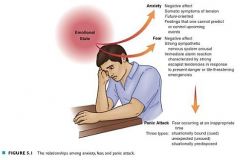
|
Relationships among anxiety, fear and panic attack
(Fig 5.1 P. 123) |
|

|
The three vulnerabilities that contribute to the development of anxiety disorders. If individuals possess all three, the odds are greatly increased that they will develop an anxiety disorder after experiencing a stressful situation.
Figure 5.3 p. 126 |
|
|
An integrated model of Generalized Anxiety Disorder
|
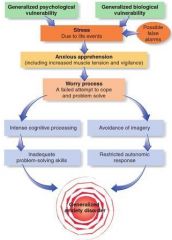
Figure 5.5 p. 131
|
|
|
A model of the causes of panic disorder with and without agoraphobia.
|
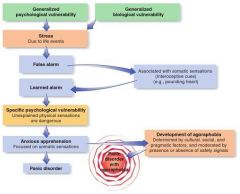
Figure 5.7 p. 137
|
|
|
A model of the various ways a specific phobia might develop.
|
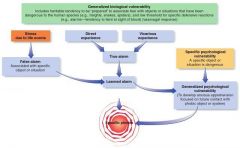
Figure 5.10 p.147
|
|
|
A model of the various ways a social phobia might develop.
|
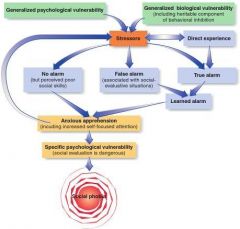
Figure5.11 p. 150
|
|
|
A model of the causes of PTSD.
|
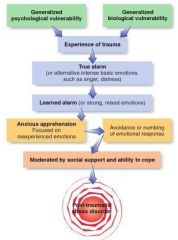
Figure 5.14 p.158
|
|
|
A model of the causes of obsessive-compulsive disorder.
|
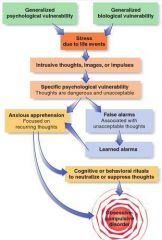
Figure 5.15 p. 163
|
|
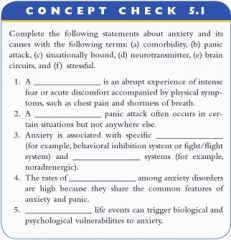
Concept Check 5.1 p.127
|
1. b - panic attack
2. c - situationally bound 3. e,d - brain circuits & neurotransmitters 4. a - comorbidity 5. f - stressful |
|
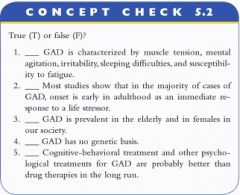
Concept Check 5.2 p. 132
|
1. True
2. False (more gradual) 3. True 4. False 5. True |

